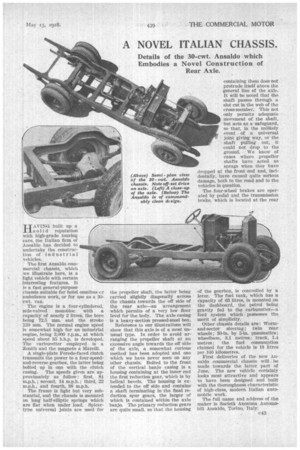A NOVEL ITALIAN CHASSIS.
Page 65

If you've noticed an error in this article please click here to report it so we can fix it.
Details of the 30-cwt. Ansaldo which Embodies a Novel Construction of Rear Axle.
AVING built up a olid reputation with high-grade touring cars, the Italian firm of Ansaldo has decided to undertake the construction of industrial vehicles.
The first Ansaldo commercial chassis, which we illustrate here, is a light vehicle with certain interesting features. It is a fast general-purpose chassis suitable for hotel omnibus cr ambulance work, or for use as a 30cwt. van.
The engine is a four-cylindered, side-valved monobloc with a capacity of nearly 2 litres, the bore being 72.5 mm. and the stroke 120 mm. The normal engine speed is somewhat high for an industrial engine, being 3,000 r.p.m., at which speed about 35 b.h.p. is developed. The carburetter employed is a Zenith and the magneto a Marelli.
A single-plate Ferodo-faced clutch transmits the power to a four-speedand-reverse gearbox, the latter being bolted up in one with the clutch casing. The speeds given are approximately as follow : first, 81 m.p.h.; second, 14 m.p.h.; third, 22 m.p.h., and fourth, 38 m.p.h.
The frame is light but very substantial, and the chassis is mounted on long half-elliptic springs which are fiat when under load. Spicertype universal joints are used for the propeller shaft, the latter being carried slightly diagonally across the chassis towards the off side of the rear axle—an arrangement which permits of a very low floor level for the body. The axle easing is a heavy-section pressed-steel box.
Reference to our illustrations will show that this axle is of a most unusual type. In order to avoid arranging the propeller shaft at an excessive angle towards the off side of the axle, a somewhat curious method has been adopted and one which we have never seen on any other chassis. Bolted to the front of the vertical banjo casing is a housing containing at the inner end the first reduction gear, which is by helical bevels. The housing is extended to the off side and contains a shaft terminating in the final reduction spur gears, the larger of which is contained within the axle banjo. The primary reduction gears are quite small, so that the housing containing them does not protrude itself above the general line of the axle. It will be noted that the shaft passes through a slot cut in the web of the cross-member. This not only permits adequate movement of the shaft, but acts as a safeguard, so that, in the unlikely event of a universal joint giving way, or the shaft pulling out, it could not drop to the ground. We know of cases where propeller shafts have acted as sprags when they have dropped at the front end and, incidentally, have caused quite serious damage, both to the road and to the vehicles in question.
The four-wheel brakes are operated by pedal and the transmission brake, which is located at the rear of the gearbox, is controlled by a lever. The fuel tank, which has a capacity of 03 litres, is mounted on the dashboard, the petrol being gravity fed to the carburetter--a feed system which possesses the merit of simplicity.
Other chassis details are : Wormand-sector steering; twin rear wheels ; 30-in. by 5-in, pneumatics; wheelbase, 3.1 metres ; track, 1.4 metres; the fuel consumption claimed for the vehicle is 18 litres per 100 kilometres.
First deliveries of the new Ansaldo commercial chassis will be made towards the latter part of June. The new vehicle certainly looks most attractive and appears to have been designed and built with the thoroughness characteristic of high-class, modern Italian automobile work.
The full name and address of the maker is Societb, Anonima. Automobill Ansaldo, Torino, Italy.












































































































